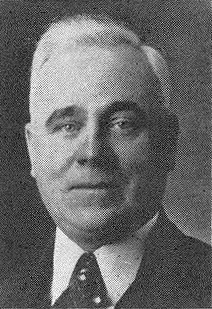John Cornelius Butler
John Cornelius Butler | |
|---|---|
 | |
| Member of the U.S. House of Representatives from New York | |
| In office January 3, 1951 – January 3, 1953 | |
| Preceded by | Chester C. Gorski |
| Succeeded by | District eliminated |
| Constituency | 44th district |
| In office April 22, 1941 – January 3, 1949 | |
| Preceded by | Pius Schwert |
| Succeeded by | Chester C. Gorski |
| Constituency | 42nd district (1941–45) 44th district (1945–49) |
| Personal details | |
| Born | July 2, 1887 Buffalo, New York |
| Died | August 13, 1953 (aged 66) Buffalo, New York |
| Resting place | Forest Lawn Cemetery, Buffalo, New York |
| Political party | Republican |
| Spouse | Frances T. Pachowiak (m. 1908-1953, his death) |
| Children | 3 |
| Occupation | Electrician Union official |
| Nickname | Jack |
John Cornelius Butler (July 2, 1887–August 13, 1953) was a Republican politician from New York.[1] He was most notable for his service as a member of the United States House of Representatives from 1941 to 1949 and 1951 to 1953.[2]
Biography
Butler was born in Buffalo, New York on July 2, 1887.[2] He attended the public schools of Buffalo and graduated from Buffalo's Central High School.[2]
Butler worked in businesses on Buffalo's Lake Erie waterfront, primarily as an electrician.[2] He later became active in several unions, including the longshoremen's, grain elevator employees', and electrical workers'.[2]
In 1941, Butler was elected to the U.S. House as a Republican in the special election held to fill the vacancy caused by the death of Pius Schwert.[2] He served from April 22, 1941, until January 3, 1949.[2] He failed to be reelected in 1948.[2] After losing his seat, Butler was employed as sales manager for the Fire Equipment Sales Company and estimator for the Beacon Electrical Engineering and Construction Company, both of Buffalo.[2]
In 1950, Butler was again elected to the U.S. House, and he served from January 3, 1951, to January 3, 1953.[2] Because his district was eliminated after the 1950 census, in 1952 Butler ran in the 42nd District, where he lost the Republican nomination to John R. Pillion.[3] As a member of Congress, Butler was best known for his opposition to the Saint Lawrence Seaway, which he believed would have a detrimental effect on Buffalo's shipping and cargo handling industries.[4]
After leaving Congress, Butler lived in retirement in Buffalo.[2] He died in Buffalo on August 13, 1953.[2] He was buried at Forest Lawn Cemetery in Buffalo.[2]
In 1908, Butler was married to Frances T. Pachowiak (d. 1971).[5][6][7] They were the parents of three sons, George, John, and Henry.[5]
References
- ^ U.S. Congress (1989). Biographical Directory of the United States Congress, 1774-1989. Washington, DC: U.S. Government Printing Office. p. 717 – via Google Books.
- ^ a b c d e f g h i j k l m Biographical Directory.
- ^ "Pillion Wins Nomination Over Butler". The Hamburg Sun and the Erie County Independent. Hamburg, NY. August 21, 1952. p. 1 – via Newspapers.com.
- ^ Committee on Public Works (1951). St. Lawrence Seaway: Hearings Before the Committee on Public Works, U.S. House of Representatives. Washington, DC: U.S. Government Printing Office. p. 1456 – via Google Books.
- ^ a b "1920 United States Federal Census, Entry for John C. Butler". Ancestry.com. Lehi, UT: Ancestry.com, LLC. Retrieved March 1, 2021.
- ^ "Death Notice, Frances T. Butler". The Post-Star. Glens Falls, NY. Associated Press. February 11, 1971. p. 2 – via Newspapers.com.
- ^ "Ontario, Canada, Roman Catholic Baptisms, Marriages, and Burials, 1760-1923, Entry for John C. Butler and Frances T. Pachowiak". Ancestry.com. Lehi, UT: Ancestry.com, LLC. Retrieved March 1, 2021.
External links
- United States Congress. "John Cornelius Butler (id: B001179)". Biographical Directory of the United States Congress.
- John Cornelius Butler at Find a Grave
